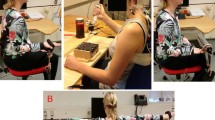Summary
Linear and curvilinear electromyogram (EMG) normalization methods were compared among ten healthy men during a simulated work cycle demanding attention and static holding of the arm (‘Solitaire test’). Maximal voluntary contractions (MVC) and gradually increasing contractions up to 70% of MVC were used for normalization in different arm postures. The test contractions studied included inward and outward rotations, abduction, shoulder elevation, and flexion in different arm positions. The shoulder load moment was calculated for the flexion tests using a simple two-dimensional model. The effect of arm posture on the EMG versus shoulder load moment relationship was studied on the following muscles: supraspinatus, infraspinatus, trapezius (three parts), deltoid (two parts) and pectoralis major. All muscles participated in the MVC tests performed, and its was not possible to suggest a single recommended test for each muscle. Differences in normalized EMG median values ranging up to 30% of MVC were found between linear and curvilinear normalization methods. Short-term repeatability of normalization based on a contraction with gradually increasing force was good. Arm posture affected the relationships between shoulder load moment and EMG activity of all muscles studied. Arm posture did not, however, have a significant effect on the estimated amplitude probability distribution functions during the simulated work task. Therefore, at least for the tasks studied, the principle of normalizing in the middle position of the range of movement was deemed acceptable.
Similar content being viewed by others
References
Basmajian JV, De Luca CJ (1985) Muscles alive. Their functions revealed by electromyography. Williams and Wilkins, Baltimore
Berenson ML, Levine DM, Goldstein M (1983) Intermediate statistical methods and applications. Prentice-Hall, New Jersey
Daniels L, Worthingham C (1980) Muscle-testing techniques of manual examination. Saunders, Philadelphia
Delagi EF, Perotto A (1980) Anatomic guide for the electromyographer — the limbs. Thomas, Springfield, Ill.
Hagberg M (1981) On evaluation of local muscular load and and fatigue by electromyography, Arb Hälsa 24:17–32
Hagberg M, Sundelin G (1986) Discomfort and load on the upper trapezius muscle when operating a wordprocessor. Ergonomics 29:1637–1645
Hagberg M, Wegman DH (1987) Prevalence rates and odds ratios of shoulder-neck diseases in different occupational groups. Br J Ind Med 44:602–610
Hof AL, Van den Berg JW (1981) EMG to force processing I: an electrical analogue to the Hill muscle model. J Biomech 14:747–758
Jonsson B (1982) Measurement and evaluation of local muscular strain in the shoulder during constrained work. J Hum Ergol 11:73–88
Jonsson B, Hagberg M (1974) The effect of different working heights on the deltoid muscle. Scand J Rehabil Med [Suppl] 3:26–32
Järvholm U, Palmerud G, Herberts P, Högfors C, Kadefors R (1989) Intramuscular pressure and electromyography in the supraspinatus muscle at shoulder abduction. Clin Orthop 245:102–109
Mathiassen SE, Winkel J (1990) Electromyographic activity in the shoulder-neck region according to arm position and glenohumeral torque. Eur J Appl Physiol 61:370–379
Mirka GA (1991) The quantification of EMG normalization error. Ergonomics 34:343–352
Nieminen H, Hämeenoja S (1989) Analysis of static and dynamic aspects of muscular strain using nonlinear trend analysis of surface EMG. In: Mital A (ed) Advances in industrial ergonomics and safety, I. Taylor and Francis, New York, pp 783–790
Olney SJ, Winter DA (1985) Predictions of knee and ankle moments of force in walking from EMG and kinematic data. J Biomech 18:9–20
Perry J, Bekey GA (1981) EMG-force relationships in skeletal muscle. CRC Crit Rev Biomed Eng 7:1–22
Ringelberg JA (1985) EMG and force production of some human shoulder muscles during isometric abduction. J Biomech 18:939–947
Schüldt K, Harms-Ringdahl K (1988) Activity levels during isometric test contractions of neck and shoulder muscles. Scand J Rebhabil Med 20:117–127
Schüldt K, Ekholm J, Harms-Ringdahl K, Németh G, Arborelius UP (1986) Effects of changes in sitting work posture on static neck and shoulder muscle activity. Ergonomics 29:1525–1537
Solomonow M, Baratta R, Shoji H, D'Ambrosia R (1990) The EMG-force relationships of skeletal muscle; dependence on contraction rate, and motor units control strategy. Electromyogr Clin Neurophysiol 30:141–152
Takala E-P, Viikari-Juntura E (1991) Loading of shoulder muscles in a simulated work cycle: comparison between sedentary workers with and without neck-shoulder symptoms. Clin Biomech 6:145–152
Veiersted KB (1991) The reproducibility of test contractions for calibration of electromyographic measurements. Eur J Appl Physiol 62:91–98
Viikari-Juntura E (1987) Interexaminer reliability of observations in physical examinations of the neck. Phys Ther 67:1526–1532
Webb Associates (1978) Anthropometric source book, vol. I. Anthropometry for designers. NASA RP-1024, IV-31-IV-39
Westgaard RH (1988) Measurement and evaluation of postural load in occupational work situations. Eur J Appl Phys 57:291–304
Winkel J, Bendix T (1986) Muscular performance during seated work evaluated by two different EMG methods. Eur J Appl Physiol 55:167–173
Yang JF, Winter DA (1983) Electromyography reliability in maximal and submaximal contractions. Arch Phys Med Rehabil 64:417–420
Author information
Authors and Affiliations
Rights and permissions
About this article
Cite this article
Nieminen, H., Takala, E.P. & Viikari-Juntura, E. Normalization of electromyogram in the neck-shoulder region. Europ. J. Appl. Physiol. 67, 199–207 (1993). https://doi.org/10.1007/BF00864215
Accepted:
Issue Date:
DOI: https://doi.org/10.1007/BF00864215




